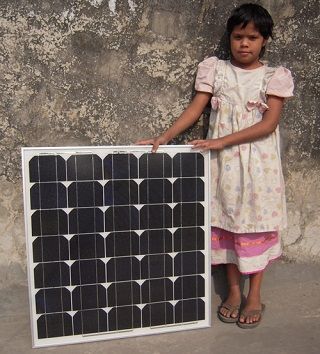Storing Solar Energy with Supercapacitors

The short answer to the question is no.
Capacitors have cost-effectiveness only in high power-density applications, i.e., those in which a large amount of energy needs to be transferred in a short period of time. The best example of this is electric vehicles, especially large heavy vehicles where it’s very difficult for batteries to discharge fast enough to produce the amount of torque required to accelerate those masses fast enough.
In most other cases, this power density is irrelevant. E.g., if you live off the grid and want to store the energy from your rooftop solar array for use at night, you need power delivered fairly slowly over the space of many hours, rather than seconds. Thus most forms of storage aimed at solar and wind are those that are less expensive ways of storing large amounts of energy, for example, batteries, pumped hydro, etc..
Also, keep in mind that storage is much more important in the case of wind energy than it is with solar, at least averaged across an entire population, like a city. That’s because the availability of solar energy mirrors very closely the load demanded on it by human activity, where the precise opposite is the case with wind, where the peak load and the peak availability of the energy exist at different times during the day.

Craig,
That’s not correct with respect to wind energy requiring less than solar in terms of storage.
While you are correct that peak wind energy comes at night and both peak solar and peak demand comes during the day… The nadir for solar energy is 0. The nadir for wind energy is rarely zero. True lulls that stop all wind turbines within a full grid hub rarely occur.
To give an example: Simply look at MISO’s real time wind generation tracking:
https://www.misoenergy.org/MarketsOperations/RealTimeMarketData/Pages/RealTimeWindGeneration.aspx
The peak may be in the night-time, but wind still produces a reasonable average load during the day as well… Furthermore, there could be multiple peaks and soft lulls during any given day, rather than solar power’s grand peak/zero generation arc, so less total energy would be needed, on average, between generation peaks.
So to envisage a system in which one were reliant only on the renewable generation and battery storage, then the wind power would in most instances require less batteries
That said, what on Earth are you considering battery storage for?
🙂
Wind has penetrated 4% of the grid, and solar is at ~0.2% We’re a LOOONNNG way from worrying about storage. Right now you can just sell your excess energy to the grid, and buy energy from the grid when you need it… and let the grid managers deal with balancing the power needs.
Re: battery storage, I believe we’ll see a time in the next few years where it’s priced under $100/kWh, and is used broadly, including on the grid, not only providing ancillary services, but also competing effectively against peaker plants. Obviously it’s not there now, but I bet we’ll see it the next five years.
Well, clearly wind overall needs more storage, if only because, in the U.S. right now, it’s more than 15 times the total energy volume of solar, but that’s not my point. I would bet that if you were able to select a randomly chosen kWh generated by wind and one of solar, there would be more value to storing the kWh of wind.
Craig,
You’re definitely correct on the statement that there’s more value to storing wind power… especially when it’s negatively priced.
Like you, I am hopeful that a breakthrough will come about which would serve to make battery storage both cheaper and higher energy density… but until then I’m happy with pumped hydrostorage.